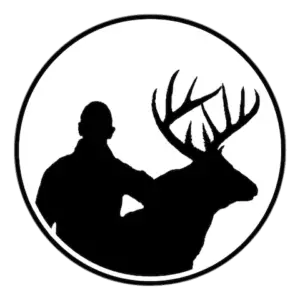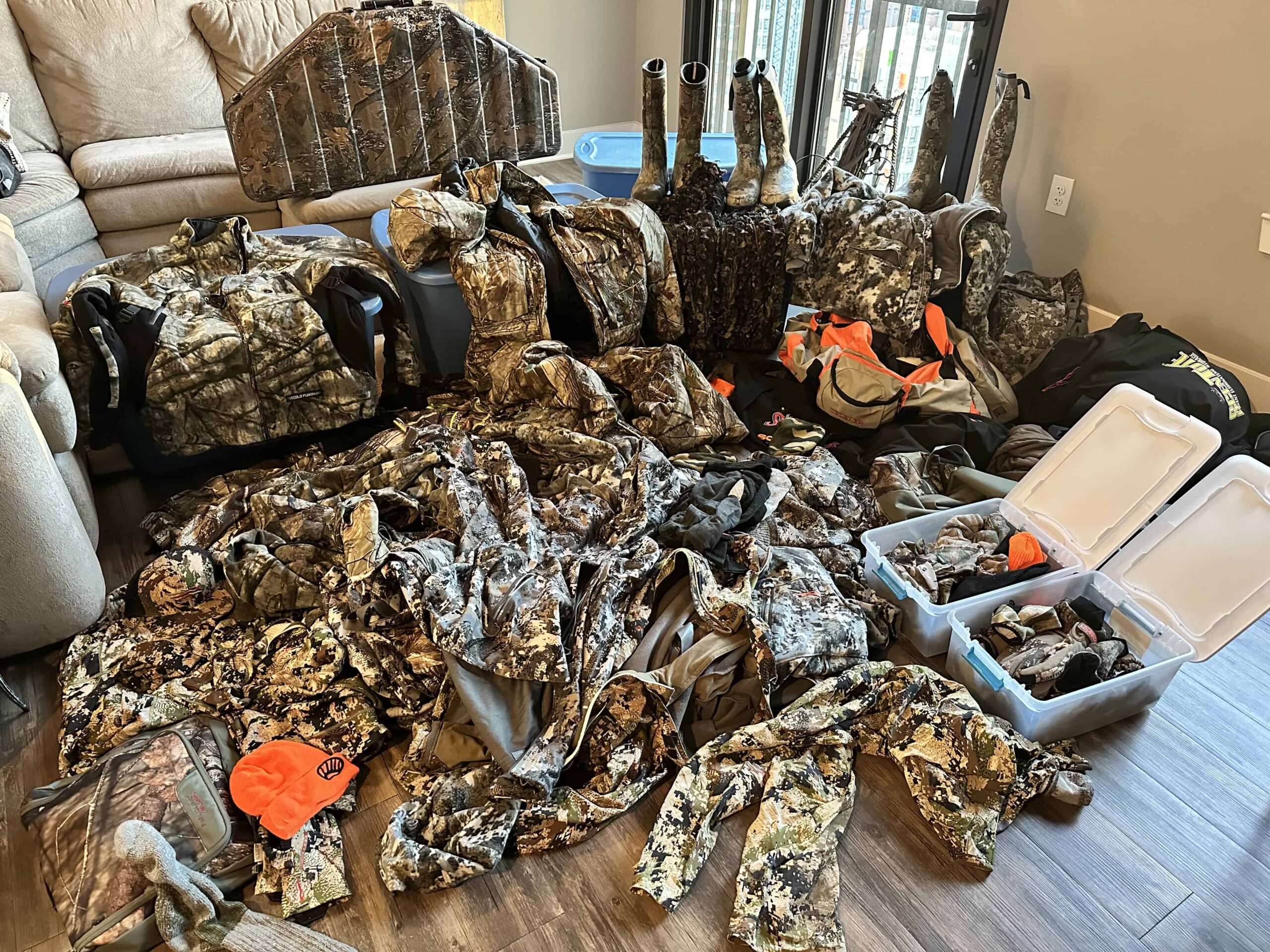When I began deer hunting, I didn’t own any camouflage clothing. Fast forward to today and now I have way more camo than what I need, as you can tell by the picture above. As a new hunter, I thought I needed to own camo for deer to not see me. However, that’s not true. Before you start buying a bunch of clothing for deer hunting, it’s important to know what you’re buying and why you are buying it. This is the reason why I’m writing this article.
Some states and public hunting areas require you to wear blaze orange, this is especially true if you are hunting during a gun season. Try to wear clothing that helps you maintain a comfortable body temperature throughout the entire hunt. Wearing camouflage clothing will help you stay undetected by deer and increase your odds of them getting close enough to take a shot at them.
It’s important to remember that you don’t need to own camouflage to kill a deer. Native Americans were killing deer successfully before camouflage clothing was even invented. However, camo does increase your odds of being more successful in the field, but I will explain that in more detail further down the page.
Buying clothing for deer hunting can be very expensive. If you’re on a tight budget, you might not even need to buy anything. You can wear everyday clothing and kill deer just like the Indians did. The main thing is that you find a way to stay comfortable and regulate your body temperature.
When I started hunting, I was a broke college student. I had to purchase the hunting clothes that I wanted over the course of a few years. Because I couldn’t buy everything that I wanted all at once, I had to prioritize the items I needed first. My goal was to eventually acquire clothing for the entire deer hunting season so that a camouflage pattern was on my outer-most layer. So, what do you buy first?
The cost is cheaper for early season outfits and gets more expensive as you buy late season outfits. It’s important to understand what the temperatures are like in your area over the course of the hunting season, or the specific time during the season when you plan on hunting the most. For me, I planned on bowhunting all season long, so I needed to acquire several outfits. However, I couldn’t buy it all at once. For early season bowhunting in October, I was able to borrow camouflage clothing from a friend. However, I needed to buy clothing for mid-season hunting (jacket, pants, base layers, hats, gloves, and boots) in November when I planned on spending the most time in the woods.
My highest priority for purchasing new hunting clothes was to buy a matched set of jacket and pants in the same camouflage pattern. My second priority was buying rubber boots. Then I bought base layers, a stocking cap, and gloves. This completed everything I needed to buy for hunting the rut in late October and most of November. The following year I was able to buy all of my own early season hunting clothes and then the year after that I bought a heavier jacket, bibs, and boots for late season.
If I would have lived in northern Wisconsin instead of central Illinois, I would have prioritized late season clothing higher than mid-season clothing. Temperatures are colder in northern Wisconsin during the rut so I would have purchased a heavier jacket and pair of bibs as my first purchase.
You will have to decide for yourself what your priorities should be. If you can afford to buy everything that you need all at once that’s great. Most guys probably won’t do that, so try to do what I did and buy everything you need over time. In the meantime, try to borrow clothes from friends or make do with ordinary clothes that you wear every day.
If you want to see which clothing items I suggest my friends to purchase, I provide two links at the bottom of this article for you can click and check that out. You might find this list useful for your purchasing decisions. Figure out what your priorities are and start buying clothes for your specific situation. However, before you scroll down to the bottom of the page and start buying anything, make sure you read the rest of this article. This next section will help make sure you consider everything before making a purchase decision based on price alone.
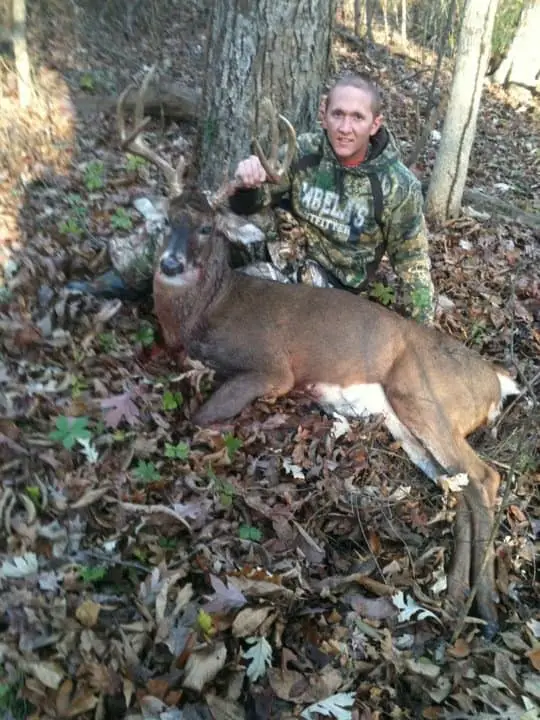
11 things to consider before buying hunting clothes
There are a lot of marketing gimmicks out there to try and get people to buy a specific product. Make sure to keep that in mind when making any purchase decision in the hunting industry. With that being said, here are 10 things to consider when buying hunting clothes:
1. State laws or rules for hunting areas such as wildlife management areas
When gun hunting, or even bow hunting in some situations, you are usually required to wear an orange vest and hat. If you aren’t wearing these items while hunting, you could get fined if you are caught without them. Even if you aren’t required to wear an orange vest and hat, you should still consider wearing them if there is a chance that other hunters could be out hunting also.
2. Camo Pattern
There are a lot of different camo patterns on the market. I’m not going to say that one pattern is better than another because deer don’t see like humans do. A lot of hunters suggest buying a camo pattern that matches your hunting environment. While that might make sense to us as humans and how we see, understand that deer can’t focus on something straight-on like we can. They also have a problem with depth-perception and seeing colors. However, deer aren’t color blind. They just see color in a dull and dark way, whereas humans see colors as bright and vivid.
The important thing to remember when buying into a specific camo pattern is that there aren’t any blue or bright white colors in the pattern. Lucky for us, most manufactures that make hunting clothes don’t produce camo products with these colors on them. Choose the pattern that you like and don’t get caught up in the hype of one pattern being better than another. A specific camo pattern won’t make a huge difference much when it comes to keeping you hidden.
Lastly, some materials are more reflective than others so make sure you purchase materials that are soft and not reflective. For example, a shiny plastic is more reflective than fleece.
3. Moisture Management
Keeping your body dry during a hunt is extremely important. It’s common to start sweating when you walk into the woods or climb up in your stand. If it’s a little cold outside, once you settle down and stop moving, your sweat will become cold also. This situation can quickly make you extremely cold and miserable, forcing you to end your hunt early so that you can leave to get warm again.
Avoid wearing clothes that absorb and hold moisture well. This is especially true for your base layers which are directly touching your skin. I suggest wearing merino wool against your skin for nearly the entire deer season. As a matter of fact, I wear merino wool as my base layer from October through January. If you aren’t familiar with merino wool, you might be thinking that wool is scratchy or is meant to be worn during cold weather. That’s not true at all.
A lot of hunting clothes are created with moisture management in mind. Just make sure you know what material your garments are made out. In most cases you will want clothes that are able to breathe and allow moisture to be wicked away from your body, so you stay dry. Keep in mind that some water-proof and late-season garments are created to keep water and heat from penetrating through the material. These kinds of garments might not allow your body to wick away the sweat very well if you get sweaty.

4. Layering
Layering deserves its own spot on this list of considerations because of how important it is for maintaining a comfortable body temperature. However, layering is closely related to moisture management. Layering just means that you wear several pieces of clothing instead of one or two heavy pieces of clothing. Investing into a system of layers will help you maintain a comfortable body temperature much easier. Most serious deer hunters have a layering system because it works so well for maintaining a comfortable body temperature.
Let’s say you go hunting on a day when the weather is mostly cloudy, 50 degrees F. and the wind speeds are 10mph. Some guys might just wear a jacket and pants with a long-sleeve shirt underneath. Although there is nothing wrong with this approach, there is a better way to dress. It’s more comfortable to wear a merino base layer against your skin, then perhaps a thin merino hoody over that with a vest and pants on top. Additionally, you could carry a light coat with you to the stand if you get a little too cold. If you don’t have options to layer-up or layer-down, it’s hard to maintain a comfortable temperature that will allow you to enjoy your entire hunt as temperatures change.
5. Bowhunting vs gun hunting
Think about how your clothes might impact your ability to shoot. This is more of a concern for recurve and compound bow hunters than it is for gun and crossbow hunters. You don’t want your string to brush against your sleeve or the front of your jacket when taking a shot. This could cause you to miss or wound a deer.
Gun season and bow season don’t always have the same dates, so make sure you know what season and time of year you will be hunting. For example, Illinois guns seasons are in late November and early December (2022). This time of year is usually much colder than it is in late October and early November when many bow hunters are hunting the pre-rut and rut.
6. Noise
When buying hunting garments, I don’t want there to be anything on my clothes that could make a sound and scare deer away. For example, some materials make louder sounds then others when you move against a tree or through vegetation. Also, I refrain from buying clothes that have Velcro, snap buttons and metal zippers. These things all make sound and carry with them the potential of spooking deer away.
There are a lot of hunting clothes on the market today that have designed and engineered their clothes to eliminate these loud sounds. Make sure you buy clothing that helps you stay quiet because it will help you stay undetected from deer. You don’t want to have to think about making loud noises if you need to do something like unzip your jacket.
7. Storage (pockets)
For some guy’s storage is a huge deal when it comes to hunting clothes. This comes down to an individual preference. For example, I’m someone that doesn’t like to take a lot of extra stuff with me into the woods so I don’t usually carry a backpack. Instead, I prefer to have a lot of pockets on my pants and jackets for my stuff. I need a place to store my phone, wallet, hunting license, range finder, grunt call, flashlight, snacks, and so on. If you plan on carrying a backpack with you to the stand every time, then you probably don’t need to worry about storage.
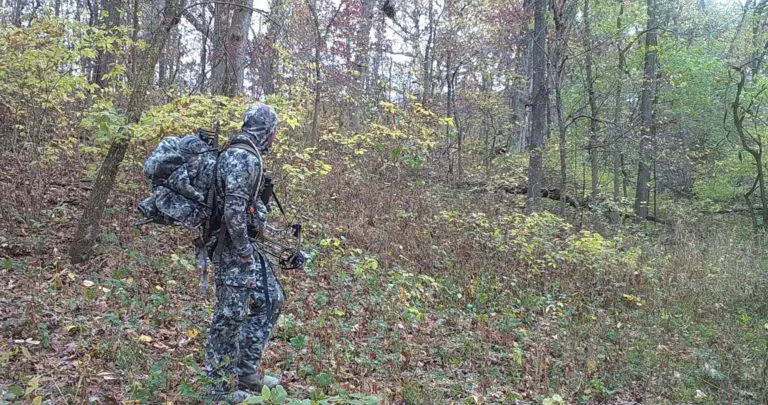
8. Hats
Like I mentioned before, you might legally be required to wear an orange hat. However, if you’re not required to wear an orange hat you don’t need a camo hat either. Any ordinary hat will do. However, you still need to keep in mind the color of the hat and the reflectiveness of that hat. Make sure it’s not made out of a shiny material or have anything reflective on it. Lastly, wear a hat that is appropriate for the season. You don’t want to your head to get cold and you can always take a hat off it you get too warm.
9. Gloves
Some gloves are easier to shoot with than others. Therefore, make sure you purchase the right sized gloves that fit your hands and fingers perfectly. You should also buy gloves that don’t make it more difficult for you to shoot your weapon. If possible, you still want to be able to feel the trigger through your gloves. I really like to wear gloves that have the tips of my thumbs and index fingers exposed. This allows me to keep my gloves on while I use my phone and also lets me touch the trigger with my skin. I use these kinds of gloves in temperature above 30 degrees F.
10. Facemasks
You may or may not want to buy a facemask. The skin on our faces can be very reflective, especially if the sun is hitting our faces directly. In that situation, wearing a facemask is a good idea to stay hidden from deer. Keep in mind that some hoodies and jackets come with a facemask built into them so you might not need to purchase a facemask at all if you buy clothes with facemasks already built into them. I have several garments for each season that have facemasks built into them and I find it to be very convenient.
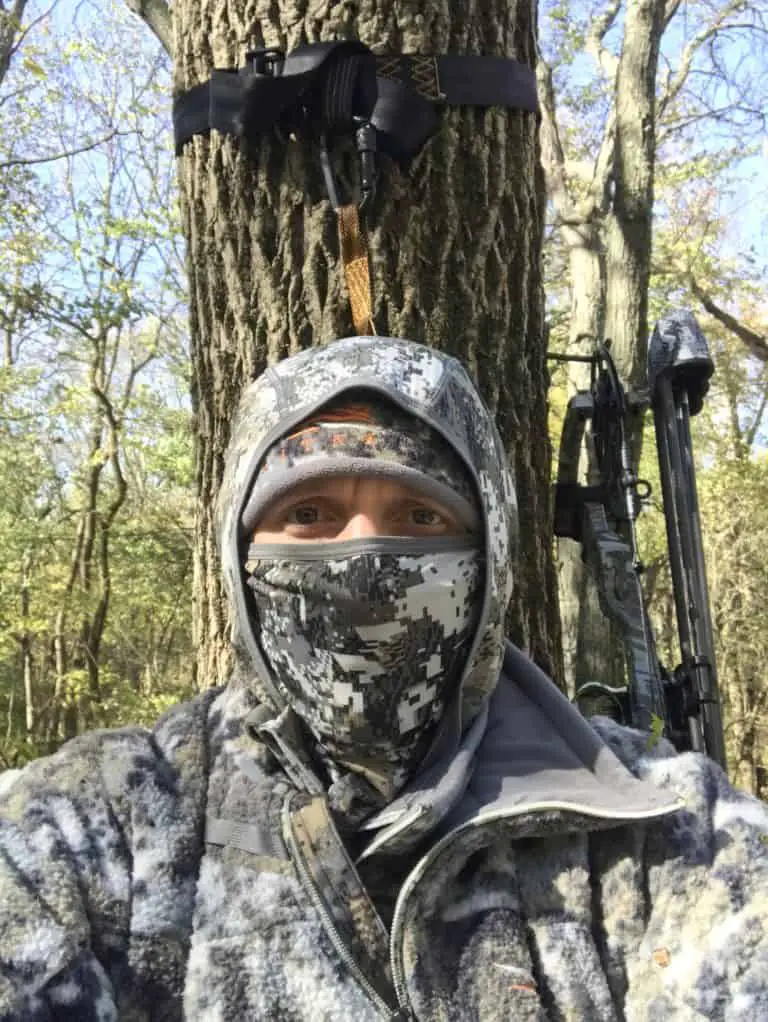
11. Boots
When buying boots you not only need to think about the temperatures that you will be hunting in, but also the terrain where you will be hunting. For example, are you going to be walking through wet areas? If so, you probably need to buy a waterproof rubber boot. Another example is hunting in mountainous terrain. In those kinds of conditions it might be best to buy a boot that you can lace up. Those boots typically breathe better and help to keep the temperature of your feet regulated. Additionally, in my experience lace-up boots do not give me blisters on my feet as easily as rubber boots do. Getting blisters usually depends on the amount of walking you plan on doing.
I own three pairs of boots for the conditions I hunt in. I own a rubber boot for early season, mid-season, and late season. Additionally, I have a pair of lace-up boots that I use for off-season scouting and shed hunting. If you can only buy one pair of boots you might just want to buy a mid-season boot and layer up with socks when weather gets colder. Once again, your purchase decisions should be specific to your situation, when and where you plan to hunt, and your budget.
